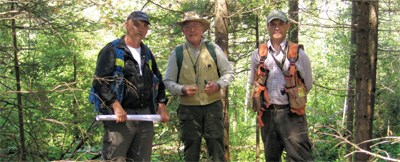Rare earth metals and rare earth elements, the collection of 17 earth elements in the periodic table (scandium, yttrium and 15 lanthanides), have been making headlines for a valid reason.
Rare earth metals and rare earth elements, the collection of 17 earth elements in the periodic table (scandium, yttrium and 15 lanthanides), have been making headlines for a valid reason. Holding unique magnetic, fluorescent, and chemical properties, these elements are often key materials used in science and technology, most notably in hybrid vehicles. The Toyota Prius, for example, contains 65 pounds of rare earth elements. Other applications include motors, metal hydride batteries, glass, auto catalysts, lasers and ceramics.Demand for these materials steadily outpaces supply, as their applications transition from innovative theory to everyday use. This creates ideal conditions for rare earth element exploration and development companies. Rare Earth Metals Inc., with a seasoned exploration team, has charted such a trajectory, and is focused on discovering economically significant rare earth element deposits in Canada, particularly those with high-quality existing infrastructure or strong potential for mine development. With project areas in Northern Ontario and Newfoundland and Labrador, the company is poised to move decisively forward in 2012.
Springer-Lavergne projectA minimum 2500-meter drill program is underway at the Lavergne-Springer Project in Northern Ontario, located 70 km east of Sudbury. This drilling is a follow-up to the company’s successful initial drilling campaign completed in 2011. The objective of the program is to continue to expand the size of the Lavergne Rare Earth Element Zones, to test for areas of higher grades, and to move the project forward to a 43-101-compliant resource. A total of seven holes were completed in the summer of 2011 to test the Lavergne–Springer REE Mineralized Zone over a strike length of 300 meters and produced drill widths varying from 79 meters to 360 meters with higher grade intersections up to 1.65% TREO (total rare earth oxides) over 90.2 meters in the most northerly hole. Results from this new drilling will be released as they become available.Ongoing mineralogy studies indicate that the mineral hosting the REEs at the Lavergne Zone is synchysite, a calcium REE fluro-carbonate mineral. The company has contracted world-renowned rare earth experts Dr. Anthony Mariano Sr. and Tony Mariano Jr. to conduct a bench metallurgical test on samples from the 2011 drilling to assess the potential to liberate the synchysite into a concentrate form. Initial results from this beneficiation work confirm synchysite is the predominant mineral source of the REE mineralization, thus eliminating complications with physical processing from other rare earth minerals. Attempts to concentrate synchysite on a bench scale were successful through the use of magnetic and gravity techniques. The fine–grained nature of the synchysite mineralization indicates flotation as a potential technique for physical processing. Additional metallurgical test-work will be completed in 2012 by a major processing laboratory focusing on a flotation process for concentrating the rare earth bearing synchysite, and a 43-101-compliant resource estimate for the Lavergne-Springer prospect is planned to be available by the third quarter of 2012.Michael Stares, president and CEO of Rare Earth Metals has stated, “The preliminary beneficiation results are extremely positive, and we are very pleased with the work done by Tony Mariano Sr. and Jr. as their test results have given us the confidence we need to bring the Lavergne-Springer project ahead at a rapid pace. This will surely add to the already very positive things that this project has going for it.”
Other rare earth projects
The Clay Howells REE deposit is located north of Kapuskasing, Ontario and hosts a magnetite iron REE deposit. After drilling programs in 2010 and 2011, a 43-101-compliant resource of 8.4 million tonnes grading 0.732% TREO, 44% Iron Oxide and 0.13% Niobium Oxide was calculated. Rare Earth Metals is actively seeking a partner to carry out the next phase of metallurgy, economic evaluation and marketing.
In Labrador, the company is focusing on two areas in what is known as the Red Wine Project Area. At the Two Tom prospect, infill drilling in 2011 has defined a 43-101 resource of 40.6 million tonnes averaging 1.18% TREO, 0.26% Niobium Oxide and 0.18% Beryllium Oxide. At Dory Pond, limited drilling has intersected up to 1.11% TREO with a heavy rare oxide to total rare earth ratio of 42%. Heavy rare earths, the last nine elements in the lanthanide group, plus Yttrium are highly sought-after with a value of up to $3,800 per kilogram in oxide form. Rare Earth Metals plans an aggressive exploration program in this area in the summer of 2012.



.jpg;w=120;h=80;mode=crop)